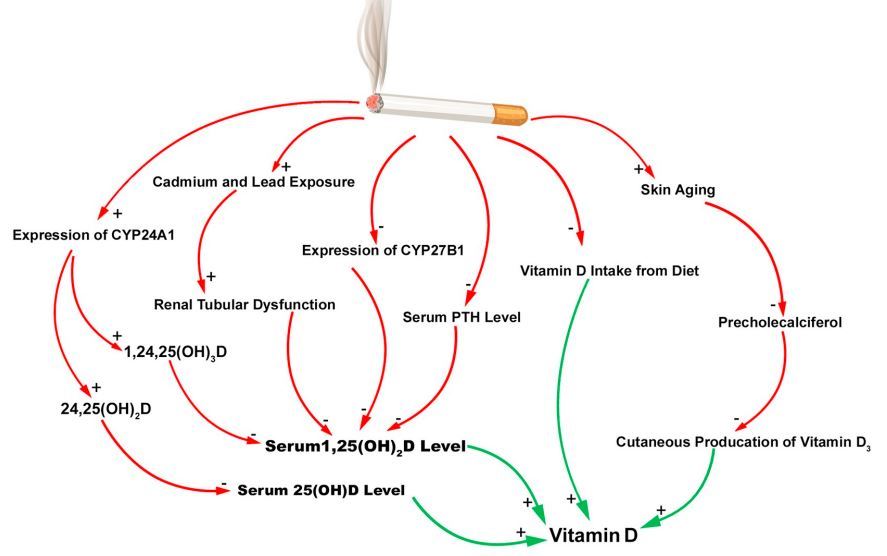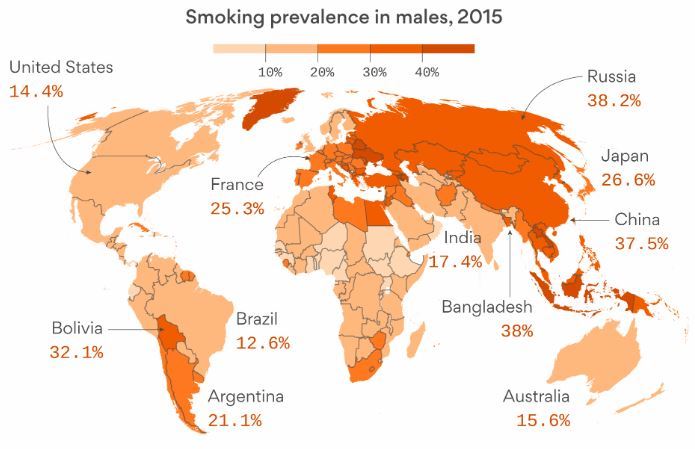Tobacco smoke is radioactive – 1 year is the same as 300 chest Xrays
The health problems of smoking go beyond radiation and the lungs
Smoking reduces vitamin D - many studies in VitaminDWiki
See also VitaminDWiki
Each ng extra vitamin D associated with better breathing (and 2X better for smokers) – March 2018
Smoking associated with 2 times fewer heart problems if high vitamin D – Sept 2016
Breathing by ever-smokers improved by monthly Vitamin D – RCT 2017
Child exposed to smoke is 1.5 X more likely to have low vitamin D – Oct 2018
Smoking associated with 9 ng less vitamin D age 40-50 – Nov 2014
Severe Myopia associated with low vitamin D and smoking (which also reduces vitamin D) - Jan 2014
Air pollution, toxins, heavy metals and smoking each result in lower Vitamin D levels – Nov 2018 has the following chart

Smoking is 36 Times Worse Than Working at a Nuclear Reactor
“In 1998, major tobacco industries' internal secret documents were made available online by the Master Settlement Agreement, revealing that the industry was aware of the presence of a radioactive substance in tobacco as early as 1959.”
“According to the Environmental Protection Agency, the industry's and our estimate of long-term lung rad of alpha particles causes 120-138 lung cancer deaths per year per 1,000 regular smokers.”
“Polonium 210 is extraordinarily toxic when ingested or inhaled. In fact, it is 4500 times more toxic than radium 226….”
Polonium, Tobacco - Wikipedia
Polonium, Tobacco at Wikipedia March 2019
Polonium-210 in tobacco contributes to many of the cases of lung cancer worldwide. Most of this polonium is derived from lead-210 deposited on tobacco leaves from the atmosphere; the lead-210 is a product of radon-222 gas, much of which appears to originate from the decay of radium-226 from fertilizers applied to the tobacco soils.
The presence of polonium in tobacco smoke has been known since the early 1960s. Some of the world's biggest tobacco firms researched ways to remove the substance—to no avail—over a 40-year period. The results were never published.
Health effects of tobacco – Wikipedia
Wikipedia March 2019
“Tobacco use is the single greatest cause of preventable death globally”
“As many as half of people who use tobacco die from complications of tobacco use. The World Health Organization (WHO) estimates that each year tobacco causes about 6 million deaths (about 10% of all deaths) with 600,000 of these occurring in non smokers due to second hand smoke”
“Some of the mineral apatite in Florida used to produce phosphate for U.S.A. tobacco crops contains uranium, radium, lead-210 and polonium-210 and radon”
Radioactive Fertilizer
Radioactive Fertilizer—The Surprising Primary Cause of Lung Cancer in Smokers Mercola Feb 2014
- “According to previous research, smoking 1 1/2 packs of cigarettes per day can expose your bronchial epithelium to a radiation dose equivalent to a radiation dose to your skin from 300 chest x-rays per year ”
Human Exposure to Radioactivity From Tobacco Smoke: Systematic Review – July 2018
Nicotine Tob Res. 2018 Jul 17. doi: 10.1093/ntr/nty111
High percentage of males on the planet still smoke
>30% in Russia, Indonesia. China, Bangladesh, Boliva, etc.

